|
|
Millennium-old Masterpieces at ART&ANTIQUE in Salzburg
|
Visit us from 11 to 20 August in the Salzburg Residenz. On our booth we exhibit many more artworks of museum-quality with the best provenances. Walk together with us through the millennia and let's celebrate art - at one of the most beautiful festivals in the world.
|
|
Jahrtausende alte Meisterwerke auf der ART&ANTIQUE in Salzburg
|
Dieser Ring ist ein bedeutendes Meisterwerk und historischer Schatz. Er gehörte einem parthischen Würdenträger, wohl einem Hohepriester und Mitglied der königlichen Familie, dessen Namen über die Jahrtausende in Vergessenheit geriet. Jetzt erlangt er wieder Bekanntheit bei den weltberühmten Salzburger Festspielen. Der parthische Goldring aus hellenistischer Zeit mit seiner gravierten und beschrifteten Lapislazuli-Gemme ist eines unserer Highlights, das erstmals auf der ART&ANTIQUE zu sehen sein wird. Er befand sich viele Jahrzehnte in der Sammlung eines französischen Diplomaten, dessen Familie ihn nun wieder der Öffentlichkeit zugänglich machte.
|
Besuchen Sie uns von 11. bis 20. August in der Salzburger Residenz. Wir zeigen auf unserem Stand Kunstwerke von musealer Qualität mit bester Provenienz. Spazieren Sie mit uns durch die Jahrtausende und lassen wir gemeinsam die Kunst hochleben – auf einem der schönsten Festivals der Welt.
|
|
|
|
Our Highlight of the Month:
|
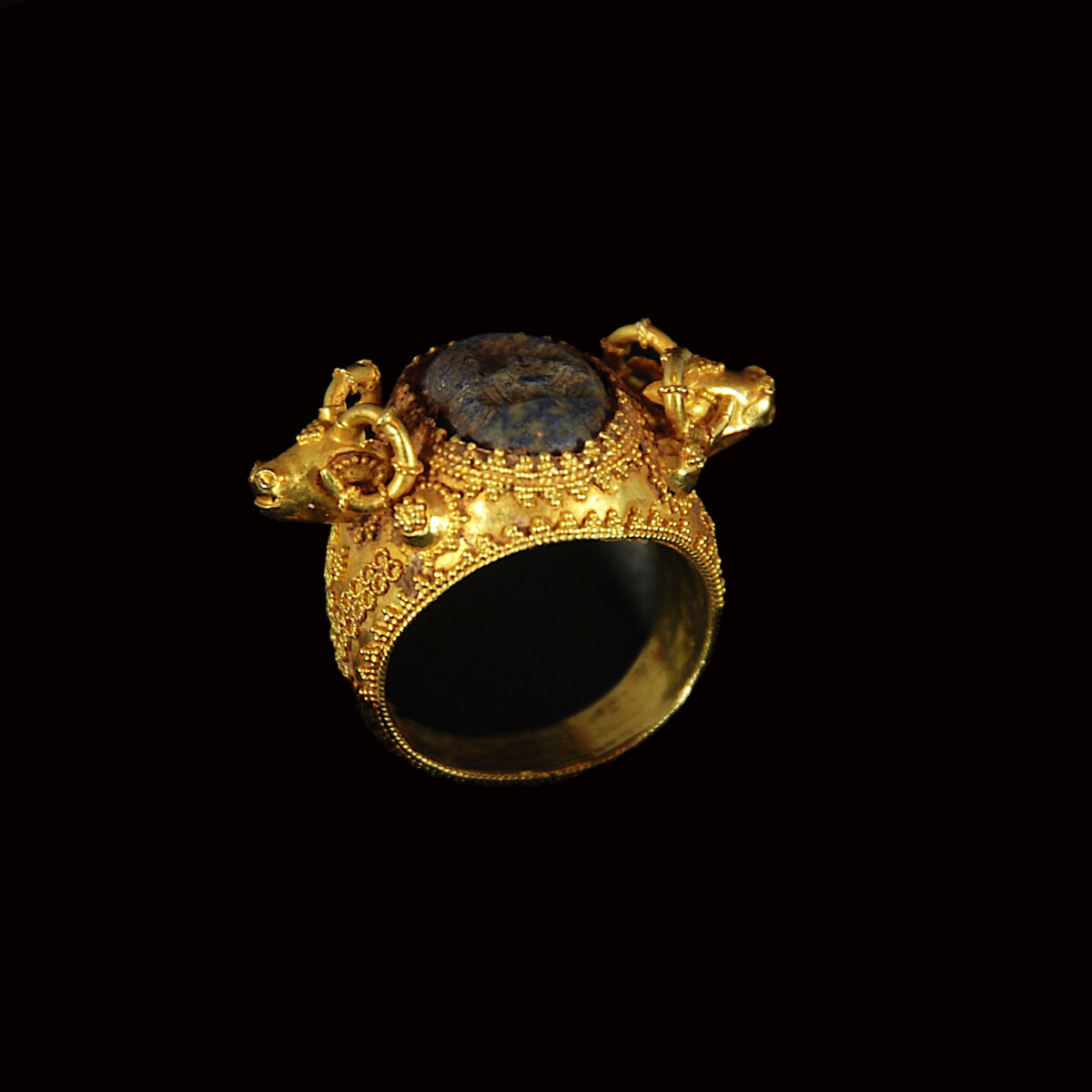
|
|
|
|
|
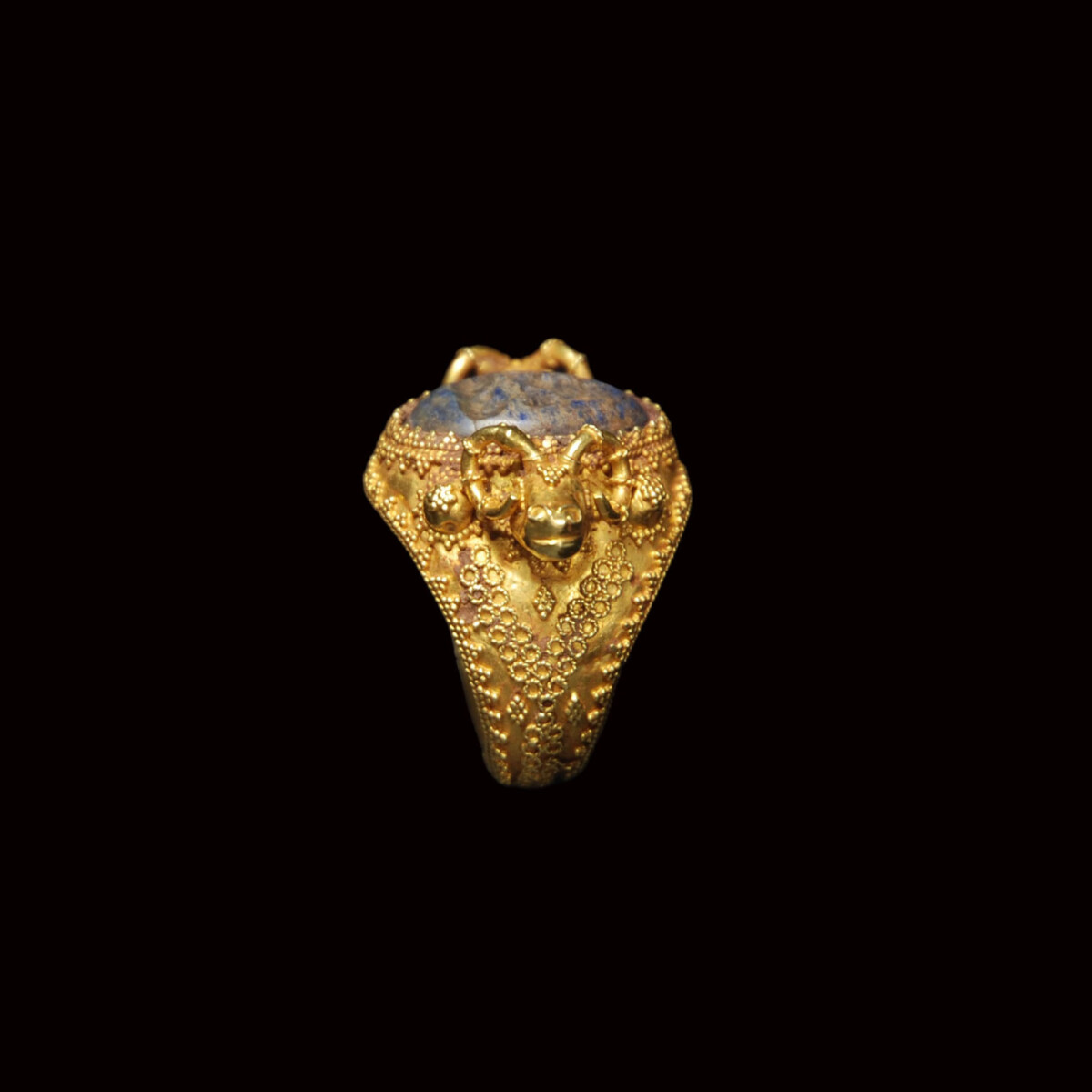
|
|
Parthian Empire – 2nd century B.C.
|
Important ring of a high ranking, so far unknown dignitary of a Parthian royal family. The masterly worked out jewellery with two bull protomes on the shoulder flanking the central gemstone, a lapis lazuli intaglio. The intaglio with the head of a dignitary with thick curly hair, cascading on the front to the forehead, and at the back to the nape. The noble man wears a cap, long, heavy earrings and a medallion around his neck. Above the head a series of seven letters in early-Pahlavi language, mentioning the name of the owner. The inscription reads “Yahbyzd”, which translates to „divine Yahb”. It must therefore be a high-ranking personality from the royal entourage, possibly a high priest. The ring is decorated throughout with the finest granulation in the shape of grapes and rings. Next to the bull heads two granules bouquets each. The high-quality workmanship of the ring with the individually soldered granules speaks clearly for a dating to the 2nd century B.C., when the influence of Hellenistic artists reached until Iran. Ready to wear. Intact and of extraordinary quality.
|
Provenance: From the family estate of a French diplomat. In the family for several decades.
Dimensions: 2.3 cm (ring diameter); 12.7 gram
Price: 38 000 Euro
|
|
|
Parthisches Reich – 2. Jahrhundert v. Chr.
|
Bedeutender Goldring eines hohen, bisher unbekannten Würdenträgers des parthischen Königshauses. Das meisterhaft gearbeitete Schmuckstück mit zwei Bullen-Protomen an der Schulter, die den zentralen Schmuckstein, eine Gemme aus Lapislazuli, flankieren. Die Gemme mit dem Kopf eines bärtigen Würdenträgers mit dicht gelocktem Haar, das ihm vorne in die Stirn und hinten bis in den Nacken fällt. Der Noble trägt eine Kappe, lange, schwere Ohrringe und ein Medaillon um den Hals. Über dem Kopf eine Folge von sieben Buchstaben in Früh-Pahlavi-Schrift, die den Namen des Besitzers nennt. Die Inschrift lautet „Yahbyzd“, was so viel wie „göttlicher Yahb“ bedeutet. Es muss sich also um eine hochgestellte Persönlichkeit aus dem königlichen Umfeld, möglicherweise um einen Hohepriester handeln. Der Ring ist durch-gehend mit feinster Granulatur in Trauben- und Ringform verziert. Neben den Bullenköpfen jeweils zwei Granulat-Sträuße. Die hochwertige Verarbeitung des Ringes mit den einzeln aufgelöteten Granulaten spricht eindeutig für eine Datierung in das 2. Jahrhundert v. Chr., als der Einfluss der hellenistischen Künstler bis in den Iran hineinwirkte. Sofort tragbar.
|
Provenienz: Aus dem Familienbesitz eines französischen Diplomaten. In der Familie seit mehreren Jahrzehnten.
Ringdurchmesser: 2,3 cm; Gewicht: 12,7 Gramm
Preis: 38.000 Euro
|
|
|
|
Selected Artworks of the Month:
|

|
|
|
|
Thracia, North Greece – 2nd-3rd century A.D.
|
Large, almost square funerary stele of a Thracian rider named Daguzein. The deceased is proudly depicted with a waving cape on his horse, which trots to the right and places its fore hoof on an altar. His mourning wife is seated under a tree with a curling snake, and looking up at him. Next to her another, standing figure, possibly their daughter. Behind the rider a servant, clearly smaller depicted. He touches with his left hand the tail of the horse. The two-line inscription below the image area reads: “ΣΥΡΑ ΤΩ ΑΝΔΡΙ ΔΑΓΟΥZΕΙΝΗ ΚΑΙ ΑΥΤΗ / Σ ΜΝΗΜΗΣ ΧΑΡΙΝ ΚΑΙ ΤΗΝ ΙΠΠΟΝ ΡΟΔΑΝ”. The translation: “Syra (had this tomb built) in memoriam for her husband Daguzein and the mare Rodan”. According to the inscription Daguzein was buried together with his horse. See for the typus the steles of the heroic Thracian riders in the Archaeological Museum Sofia as well as in the museum in Florina in Greece. Mounted. Unrestored.
|
Provenance: With art gallery Markus Proell, Brussels, Belgium, 1980s. There acquired by the German collection K. V. Last in a family estate.
Dimensions: 66 cm x 59 cm
Price: 22 000 Euro
|
|
|
Thrakien, Nordgriechenland – 2.-3. Jahrhundert n.Chr.
|
Große, fast quadratische Grabstele eines thrakischen Reiters mit dem Namen Daguzein. Der Verstorbene ist stolz mit wehendem Umhang auf seinem Pferd dargestellt, das nach rechts trabt und einen Vorderhuf auf einem Altar ablegt. Seine trauernde Frau sitzt unter einem Baum, auf dem sich eine Schlange ringelt und blickt zu ihm auf. Neben ihr eine weitere, stehende Figur, wohl die gemeinsame Tochter. Hinter dem Reiter ein Diener, deutlich kleiner dargestellt. Er berührt mit seiner linken Hand den Schweif des Pferdes. Die zweizeilige Inschrift unter dem Bildfeld lautet: „ΣΥΡΑ ΤΩ ΑΝΔΡΙ ΔΑΓΟΥZΕΙΝΗ ΚΑΙ ΑΥΤΗ / Σ ΜΝΗΜΗΣ ΧΑΡΙΝ ΚΑΙ ΤΗΝ ΙΠΠΟΝ ΡΟΔΑΝ“. Die Übersetzung: „Syra (hat dieses Grab errichten lassen) für ihren Mann Daguzein zum Gedenken und die Stute Rodan.“ Der Inschrift nach dürfte Daguzein also gemeinsam mit seinem Pferd bestattet worden sein. Vergleiche zum Typus die Stelen der heroischen thrakischen Reiter im Archäologischen Museum Sofia sowie im Museum von Florina in Nordgriechenland. Gesockelt.
|
Provenienz: Kunsthandel Markus Proell, Brüssel, 1980er Jahre. Dort erworben von der deutschen Sammlung K. V. Bis zuletzt in Familienbesitz.
Dimensionen: 66 cm x 59 cm
Preis: 22.000 Euro
|
|
|
|
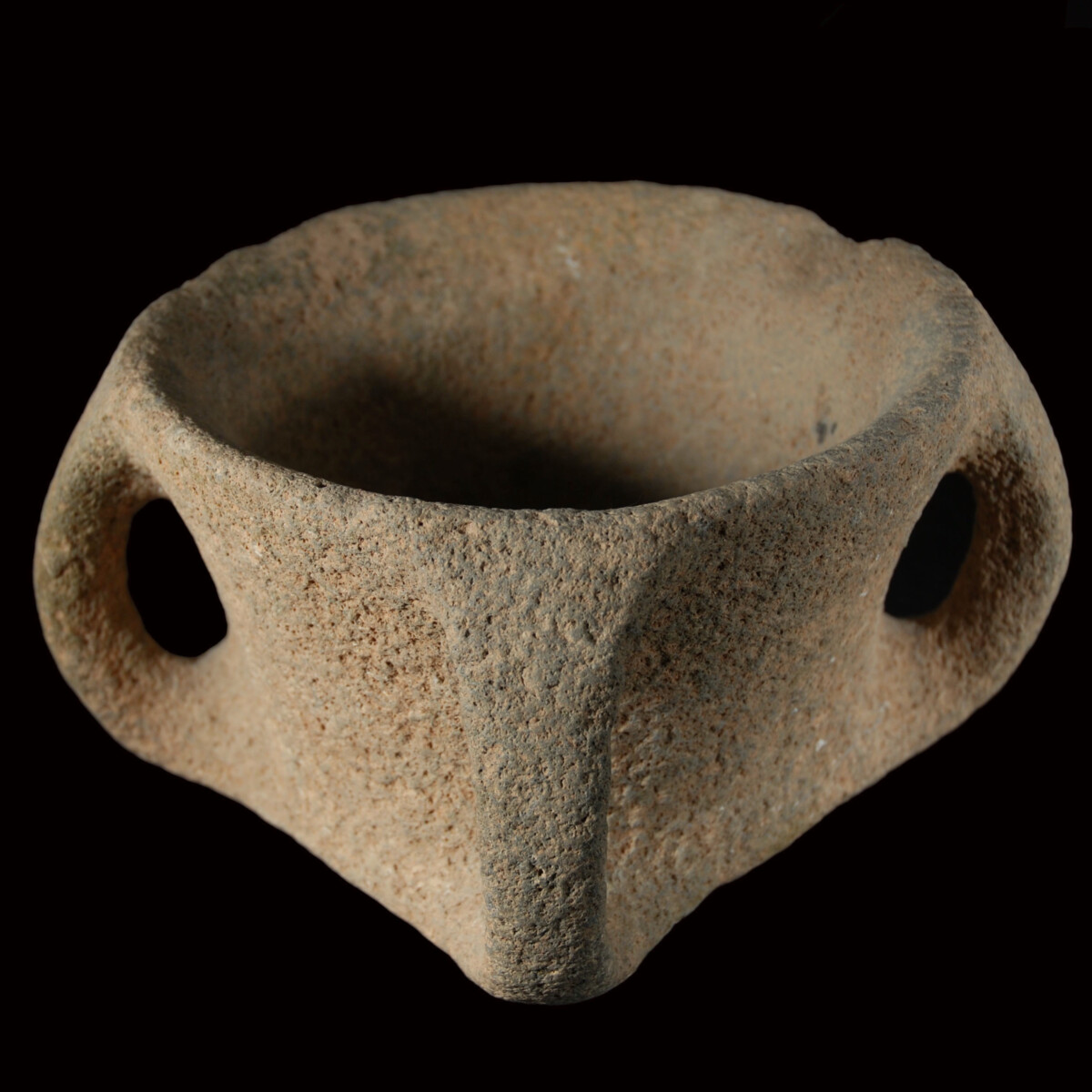
|
|
|
|
|
Large vessel made of one single basalt piece from the early settlements of the Jordan Valley. The deep-walled, round bowl is flattened at the base, and has four semi-circular handles which reach from the top to the bottom rim. The wall extends upwards, the rim is rounded and slightly turned outwards. Early Bronze Age vessels such as the present one were found in the Jordan Valley, they possibly served for ritual ceremonies. See the bowl with the same shape and additionally decorated with a relief in the Israel Museum with the inventory number IAA (Israel Antiquities Authority): 1987-1394, which was found in the Beit She’an valley.
|
Provenance: Private collection Shlomo Moussaieff (1925-2015), Israel. Acquired between 1948 and 2000.
Dimensions: 13 cm high; 27 cm in diameter
Price: 16 000 Euro
|
|
|
Levante – 3500-3000 v. Chr.
|
Großes, aus einem Stück Basalt gefertigtes Gefäß aus einer frühen Besiedelung des Jordantals. Die tiefwandige, runde Schale ist unten flach und hat vier halbrunde Henkel die vom oberen bis zum unteren Rand reichen. Die Wandung erweitert sich nach oben, der Rand ist abgerundet und leicht nach außen gedreht. Frühbronzezeitliche Gefäße wie dieses wurden im Jordantal gefunden, sie dienten wohl zu kultischen Zwecken. Vergleiche dazu die gleichförmige und zusätzlich mit einem Relief verzierte Schale im Israel Museum mit der Inventarnummer IAA (Israel Antiquities Authority): 1987-1394, die im Beit She’an Tal gefunden wurde.
|
Provenienz: Privatsammlung Shlomo Moussaieff (1925-2015), Israel. Erworben zwischen 1948 und 2000.
Höhe: 13 cm; Durchmesser: 27 cm
Preis: 16.000 Euro
|
|
|
|
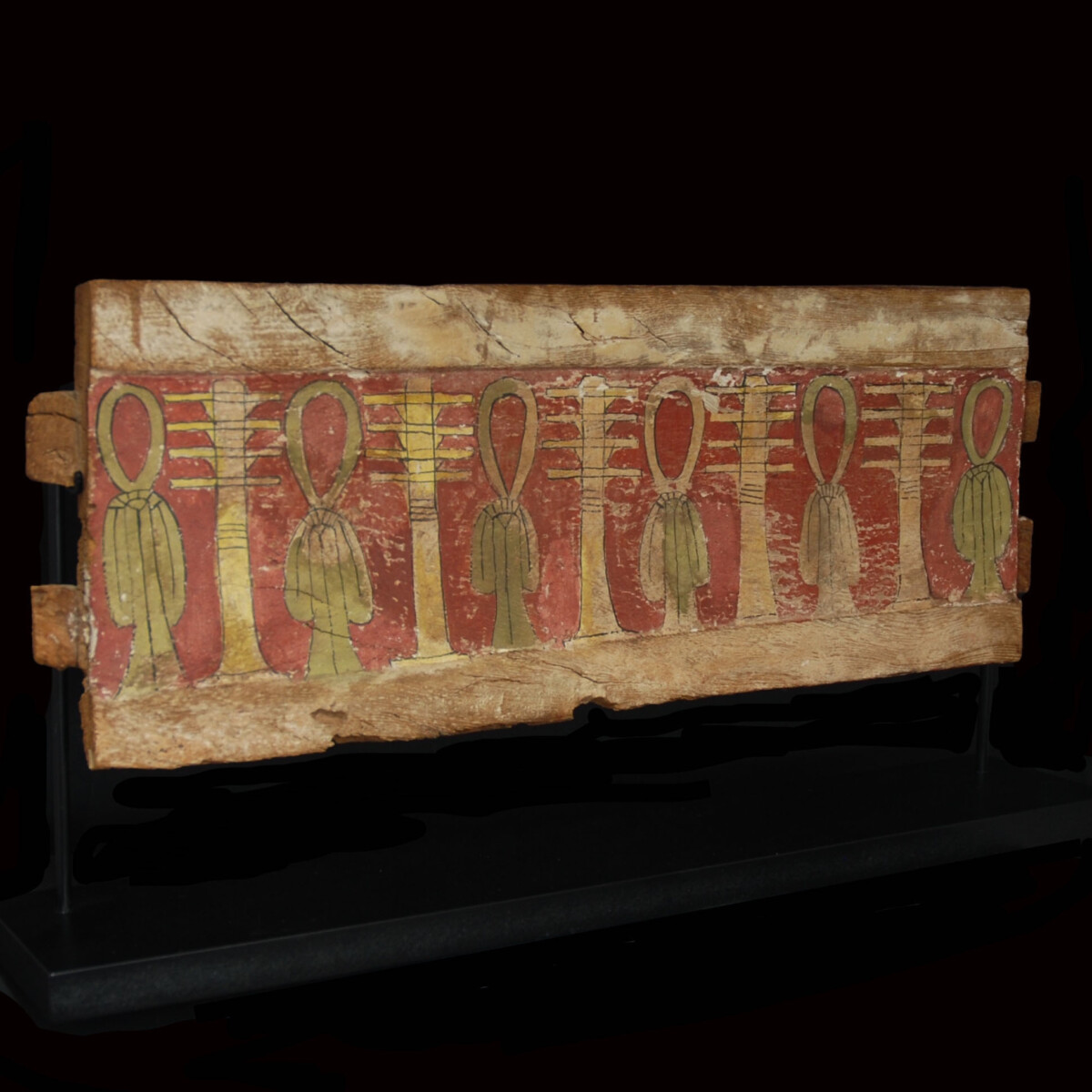
|
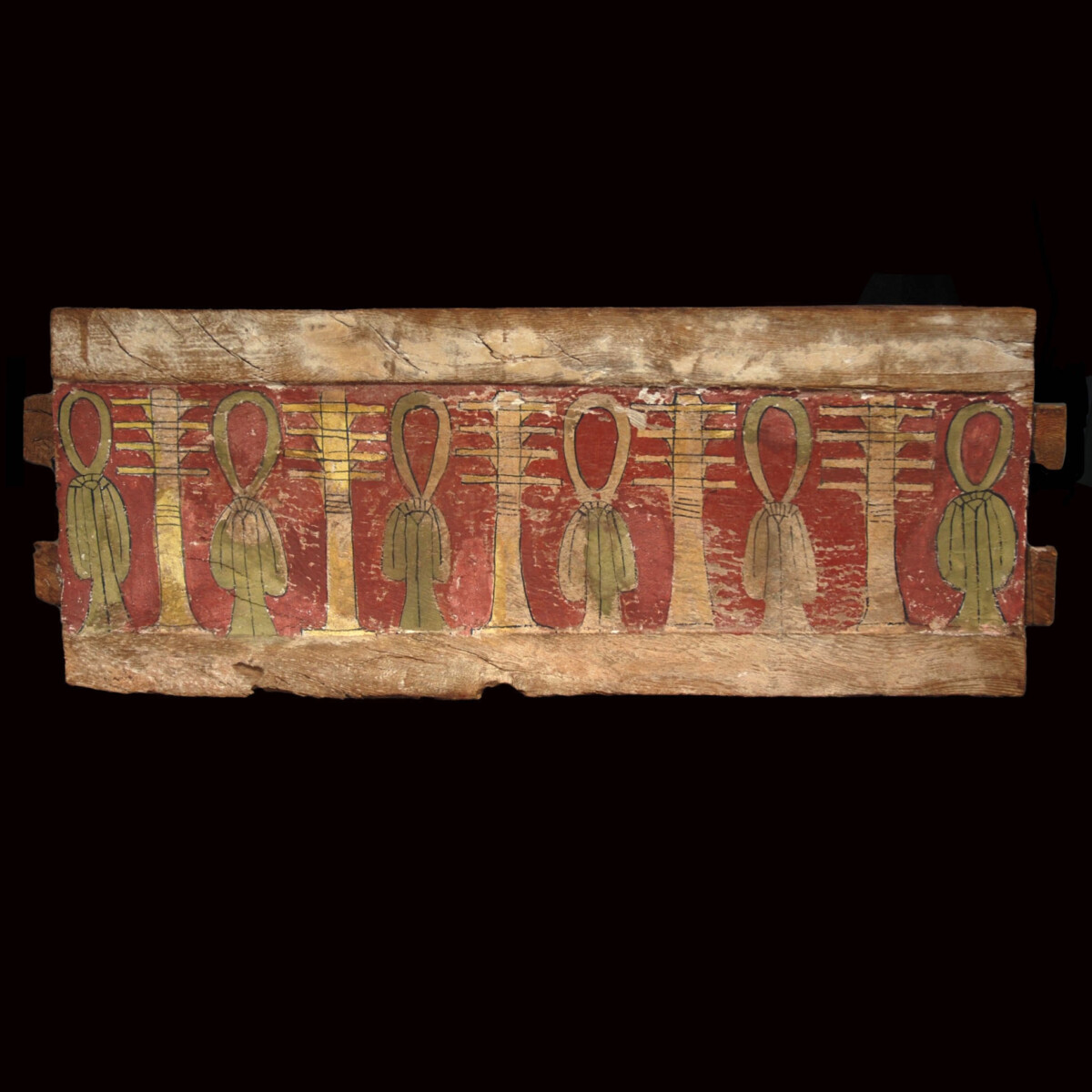
|
|
Egypt – Late period, 664-332 B.C.
|
Large part of a wood sarcophagus with polychrome paint depicting alternately six tyet symbols and five djed pillars on a red background. The tyet symbols, also known as knots of Isis, are associated with the goddess Isis and are the symbol for eternal life. This is underlined by the green color, in which they are painted. The djed pillar is one the oldest and most common Egyptian symbols and is linked to the highest god Osiris, Isis’ husband. It is also considered as the “backbone of Osiris” and equated with endurance and eternity. The present painted bar with the symbols of the highest divine couple belonged to a lower part of the sarcophagus and should promise eternal life for the deceased. Mounted.
|
Provenance: French private collection, acquired 1981 in the gallery G. Maspero in Paris, France. With a copy of the certificate by Marianne Maspero of 17 January 1981.
Dimensions: 18.1 cm x 48.2 cm
|
|
|
Ägypten – Spätzeit, 664-332 v. Chr.
|
Großer Teil eines hölzernen Sarkophags mit polychromer Bemalung, die abwechselnd sechs Tit-Symbole und fünf Djed-Pfeiler auf rotem Grund zeigt. Die Tit-Symbole, auch Isisknoten genannt, stehen in enger Verbindung mit der Göttin Isis und sind Zeichen für das ewige Leben. Das wird durch die grüne Farbe, in der sie aufgemalt sind, nachhaltig unterstrichen. Der Djed-Pfeiler ist eines der ältesten und häufigsten ägyptischen Symbole und steht in Zusammenhang mit dem obersten Gott Osiris, dem Gatten der Isis. Er wird auch als „Rückgrat des Osiris“ assoziiert und mit Dauer und Ewigkeit gleichgesetzt. Die hier aufgemalte Leiste mit den Symbolen des obersten Götterpaares gehörte zum unteren Teil des Sarkophags und sollte dem Verstorbenen ewiges Leben verheißen. Gesockelt.
|
Provenienz: Französische Privatsammlung, erworben 1981 in der Galerie G. Maspero in Paris. Mit Kopie des Zertifikats von Marianne Maspero vom 17. Jänner 1981.
Dimensionen: 18,1 cm x 48,2 cm
Preis: 4.400 Euro
|
|
|
|

|
|
|
|
|
|
Egypt – 3rd Intermediate period, 21st-24th dynasty, 1075-715 B.C. Possibly New Kingdom.
|
Monumental limestone head of a pharaoh in form of Osiris. The king in personification of the god of the afterlife, the resurrection and of the Nile with deeply engraved eyes and brows, which once held precious inlays. The mouth is closed, with broad lips hinting a smile. The pharaoh wears the White Crown of Upper Egypt (Hedjet) and the false beard. A perforation on the forehead refers to a separately worked out uraeus, which once adorned the head. At the back remains of a possibly inscribed pillar. The inscription seems to be consciously knocked off, the head purposefully devastated, suggesting a damnation memoriae, which should destroy the memory of this pharaoh. A dating of the head to the 3rd Intermediate Period is probable, whereby more recent investigations date the head with its rounded face to the New Kingdom. Then even an attribution to Hatshepsut could not be excluded.Mounted.
|
Provenance: French private collection, acquired between the 1950s to the 1960. Prior to 2012 with Courcelles Antiquités Galerie Cazals de Fabel, Paris. There acquired by the gallery Chenel in Paris. With a copy of the invoice and the French antiquities passport.
Dimensions: 39 cm high
|
|
Ägypten – Spätestens 3. Zwischenzeit, 21.-24. Dynastie, 1075-715 v. Chr.
Möglicherweise Neues Reich
|
Monumentaler Kalksteinkopf eines Pharaos in der Gestalt des Osiris. Der König in der Personifikation des Gottes des Jenseits, der Wiedergeburt und des Nils mit tief gravierten Augen und Brauen, die einst kostbare Einlagen trugen. Der Mund ist geschlossen, mit breiten Lippen und dem Ansatz eines Lächelns. Der Pharao trägt die weiße Krone Oberägyptens (Hedjet) und den falschen Götterbart. Eine Lochung auf der Stirn verweist auf eine separat gearbeitete Uräus-Schlange, die den großen Kopf einst schmückte. Hinten Reste des wohl einst beschriebenen Rückenpfeilers. Die Inschrift scheint bewusst abgeschlagen, der Kopf gezielt devastiert, was auf eine Damnatio memoriae hindeutet, die das Andenken an diesen Pharao auslöschen sollte. Eine Datierung des Kopfes in die 3. Zwischenzeit ist wahrscheinlich, wobei neuere Untersuchungen den Kopf mit seinem rundlichen Gesicht in das neue Reich datieren. Dann wäre selbst eine Zuordnung an Hatschepsut nicht ausgeschlossen. Gesockelt.
|
Provenienz: Französische Privatsammlung, erworben in den 1950er bis 1960er Jahren. Vor 2012 bei Courcelles Antiquités Galerie Cazals de Fabel, Paris. Dort erworben von der Galerie Chenel in Paris. Mit Kopie der Rechnung und französischem Antikenpass.
Höhe: 39 cm
Preis: 12.000 Euro
|
|
|
|
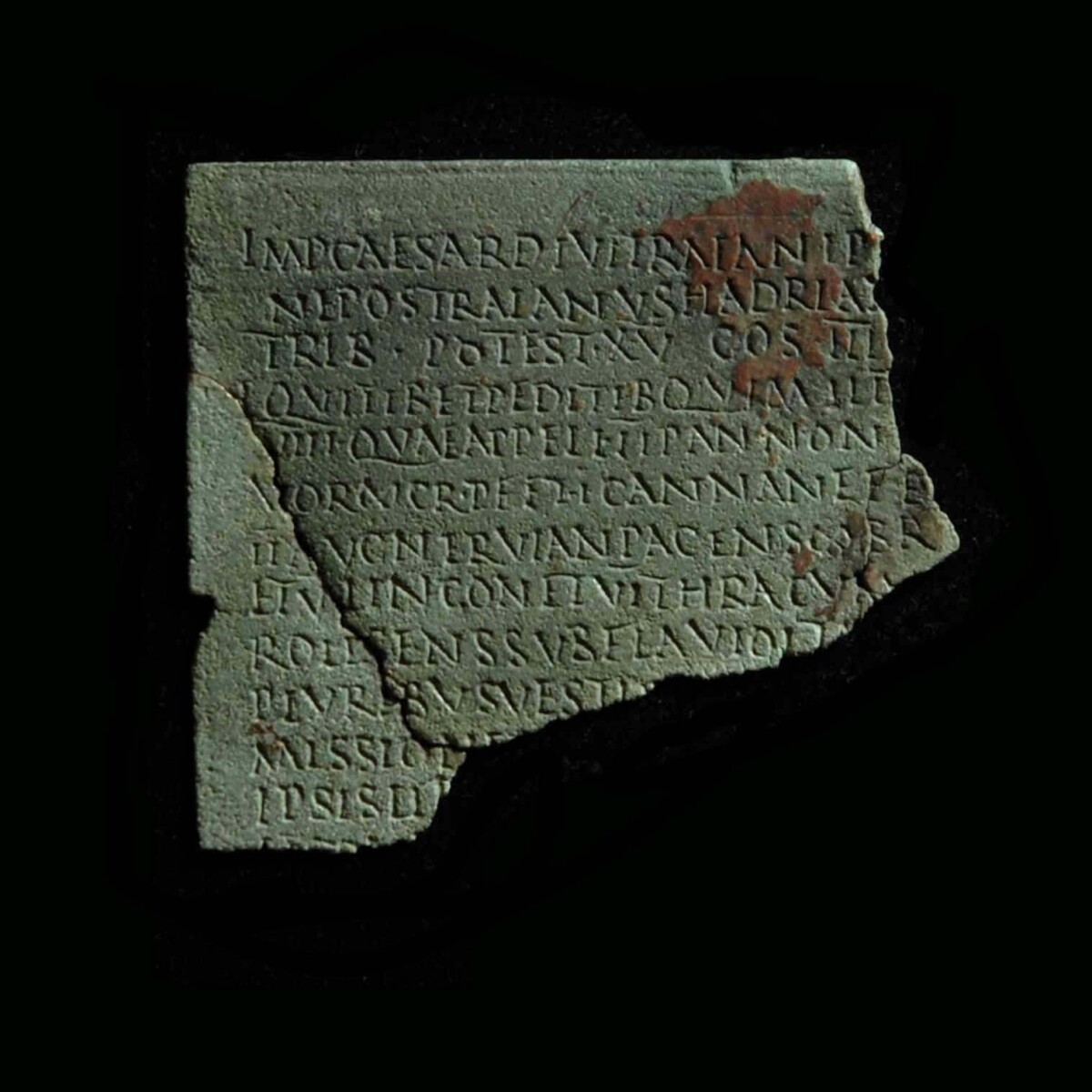
|
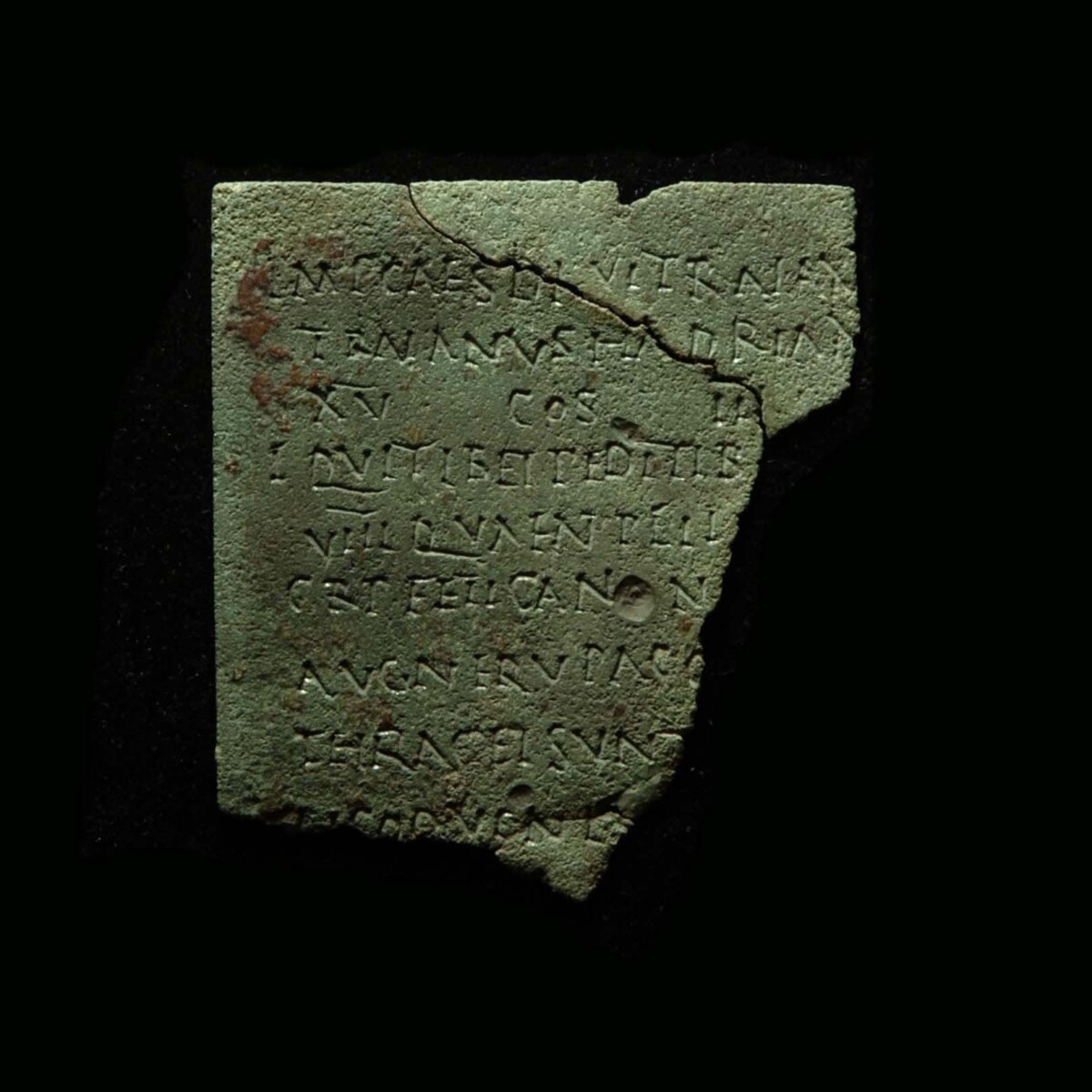
|
|
Roman Empire – 130-131 A.D.
|
Very finely inscribed military diploma of an auxiliary unit from the period of Emperor Hadrian. Preserved are two belonging fragments from the left upper part of Tabella I. Listed in the text are eight cohorts and one Ala, namely Ala II Pannoniorum. In addition, T. Flavius Italicus is mentioned, who was the governor of the province Dacia Porolissensis during this period. Published in: P. Holder “Roman Military Diplomas V (2006)”, p. 781, Nr. 378. As well as in: Peter Weiß “ZPE 141”, 2002, p. 248-251.
|
Provenance: From the German collection Peter Weiß, acquired between 1967 and 2015.
Dimensions: 6.6 cm x 7.3 cm
Price: 6 000 Euro
|
|
|
Römisches Reich – 130-131 n. Chr.
|
Besonders fein beschriebenes Militärdiplom einer Auxiliareinheit aus der Zeit des Hadrian. Erhalten sind zwei zusammengehörige Fragmente von der linken oberen Seite der Tabella I. Im Text sind acht Kohorten und eine Ala, nämlich die Ala II Pannoniorum aufgelistet. Darüber hinaus wird T. Flavius Italicus erwähnt, der in dieser Zeit Statthalter der Provinz Dacia Porolissensis war. Publiziert in: P. Holder "Roman Military Diplomas V (2006)", S. 781, Nr. 378. Sowie in: Peter Weiß „ZPE 141“, 2002, S. 248-251.
|
Provenienz: Aus der deutschen Sammlung Peter Weiß, erworben zwischen 1967 und 2015.
Dimensionen: 6,6 cm x 7,3 cm
Preis: 6.000 Euro
|
|
|
|
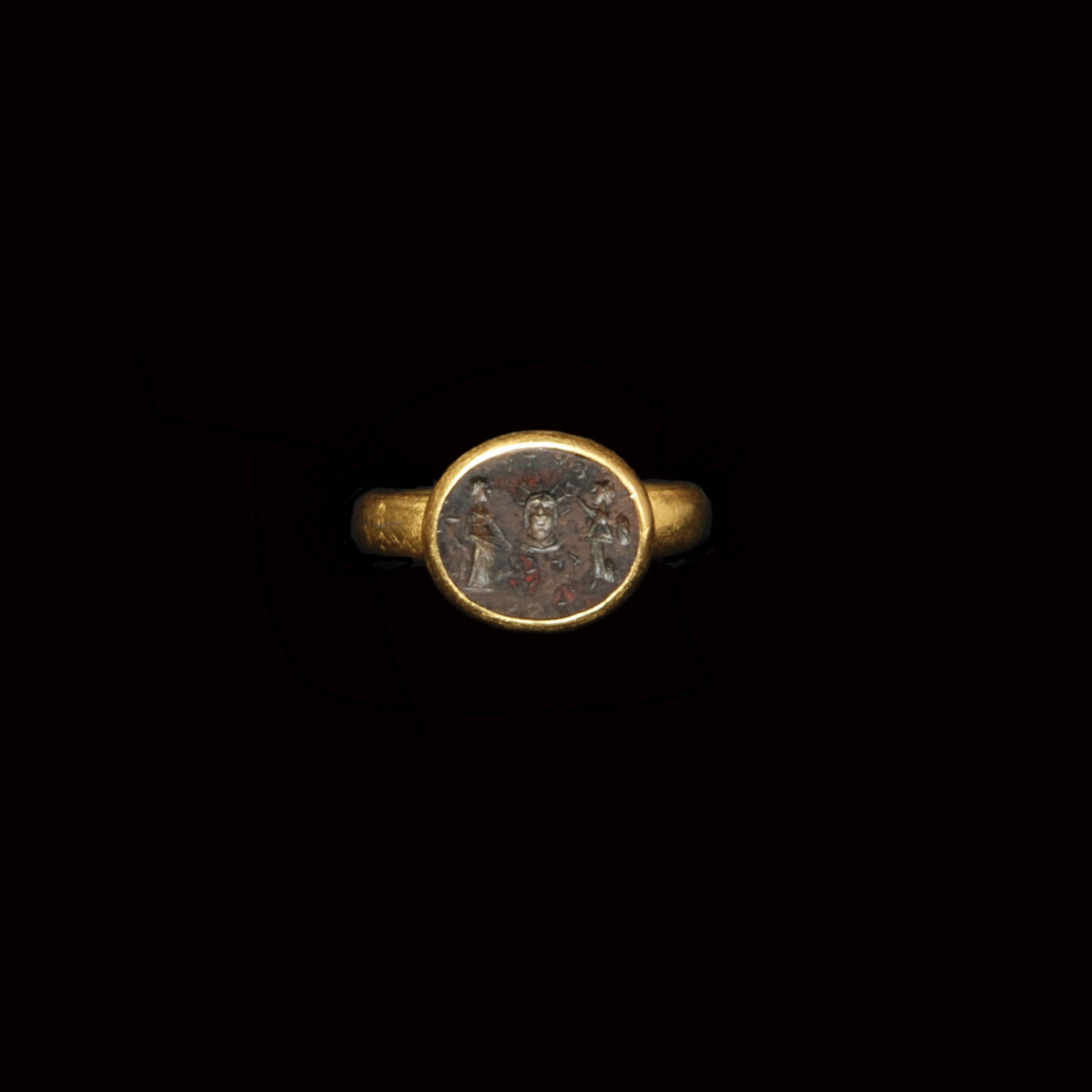
|
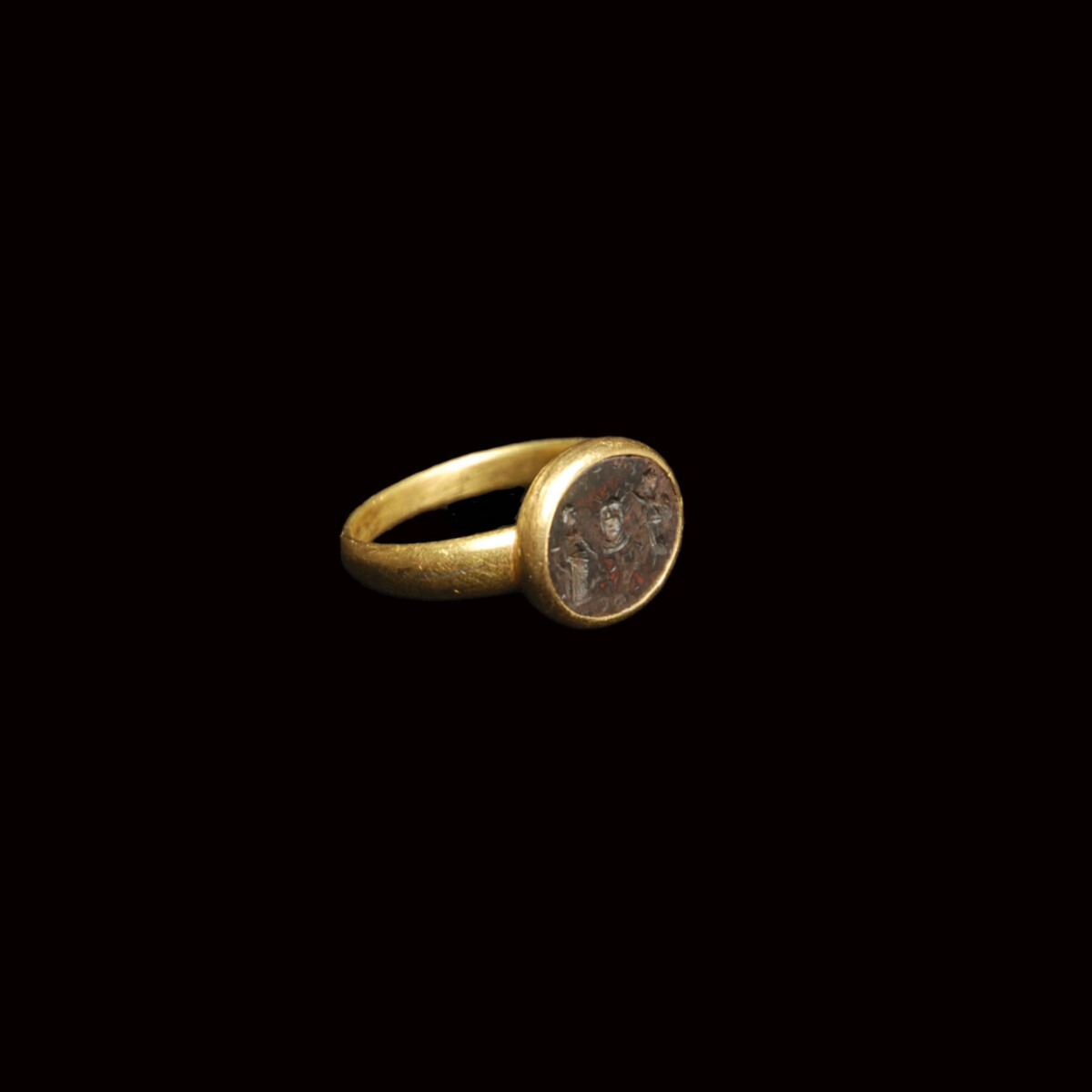
|
|
Roman Empire – 2nd-3rd century A.D.
|
Modern 21.6 carat gold ring with a 900 hallmark on the inside, with a Roman magical bloodstone intaglio. The oval gemstone depicts in the centre a bust of sun god Sol with a radiate crown. To his left stands the goddess of fortune Fortuna with a cornucopia. On his right side he is crowned by the winged goddess of victory Victoria. Above the bust of Sol the Greek letters EYTY in mirror writing, which for ευτυ(χει) translates to “be happy”. Below more Greek capital letters, which stand for abbreviations for good wishes.
|
Provenance: From a French private collection, acquired in the 1990s.
Dimensions: 1.9 cm in diameter (ring); 6.1 gram
Price: 4 800 Euro
|
|
|
Römisches Reich – 2.-3. Jahrhundert n. Chr.
|
Moderner 21,6 Karat Goldring mit 900er Punze an der Innenseite mit einer römischen magischen Gemme aus Heliotrop. Die ovale Gemme zeigt in der Mitte eine Büste des Sonnengottes Sol mit Strahlenkrone. Links von ihm steht die Glücksgöttin Fortuna mit Füllhorn. Von seiner rechten Seite wird er von der geflügelten Siegesgöttin Victoria bekrönt. Über der Büste des Sol die griechischen Buchtstaben EYTY in Spiegelschrift, die für ευτυ(χει) übersetzt: „sei glücklich“ stehen. Darunter weitere griechische Großbuchstaben, die als Abkürzung für Glückswünsche dienen. Sofort tragbar.
|
Provenienz: Aus französischer Privatsammlung, erworben in den 1990er Jahren.
Durchmesser Ring: 1,9 cm; Gewicht: 6,1 Gramm
Preis: 4.800 Euro
|
|
|
|

|
|
|
|
|
|
Greece/Apulia – 3rd century B.C.
|
Elaborately modelled terracotta statuette of a dolphin, which is considered a friend and lifesaver of humans. The body is finely curved with a raised, heart-shaped fin tail. The snout is flat and far protruding, the eyes looking determinedly straight. On the sides the pectoral fins (flippers) are finely ribbed, the back fin is short. The dolphin is depicted in motion. With beautiful color remains. A perforation on the back indicates that once a separately worked out statuette of Eros was affixed. Eros riding a dolphin was a popular motive since the 5th century B.C. The depiction can be found on mosaics, coins and marble sculptures. See for a similar example, possibly from the same workshop at Christie’s New York on 7 December 2007, lot 496. An example with a belonging Eros figure, see Bonhams auction London on 30 December 205, lot 42. Mounted.
|
Provenance: Belgian private collection, acquired in early 2000 from André de Munter Archaéologie, Brussels, Belgium. With the original expertise and inventory card by André de Munter Archaéologie.
Dimensions: 16.7 cm long
Price: 3 600 Euro
|
|
|
Griechenland/Apulien – 3. Jahrhundert v. Chr.
|
Kunstvoll modellierte Terrakotta-Statuette eines Delfins, der als Freund der Menschen und Lebensretter galt. Der Körper fein geschwungen mit angehobener, herzförmiger Schwanzflosse. Das Maul ist flach und weit nach vorne gezogen, die Augen blicken entschlossen geradeaus. Seitlich sind die Vorderflossen (Flipper) fein gerillt, die Rückenflosse ist kurz. Der Delfin ist in Bewegung dargestellt. Mit schönen Farbresten. Eine Lochung am Rücken weist darauf hin, dass einst eine separat gearbeitete Statuette des Eros dort befestigt war. Der den Delfin reitende Eros war ein beliebtes Motiv seit dem 5. Jahrhundert v. Chr. Die Darstellung findet sich auch auf Mosaiken, Münzen und als Marmorskulptur. Vergleiche ein sehr ähnliches Exemplar wohl aus derselben Werkstatt bei Christie’s New York am 7. Dezember 2000, Los 496. Ein Exemplar mit zugehöriger Eros-Figur siehe Bonhams Auktion London vom 30. September 2015, Los 42. Gesockelt.
|
Provenienz: Belgische Privatsammlung, erworben Anfang der 2000er Jahre bei André de Munter Archäologie in Brüssel. Mit Original-Expertise und Inventurkarte von André de Munter.
Länge: 16,7 cm
Preis: 3.600 Euro
|
|
|
|
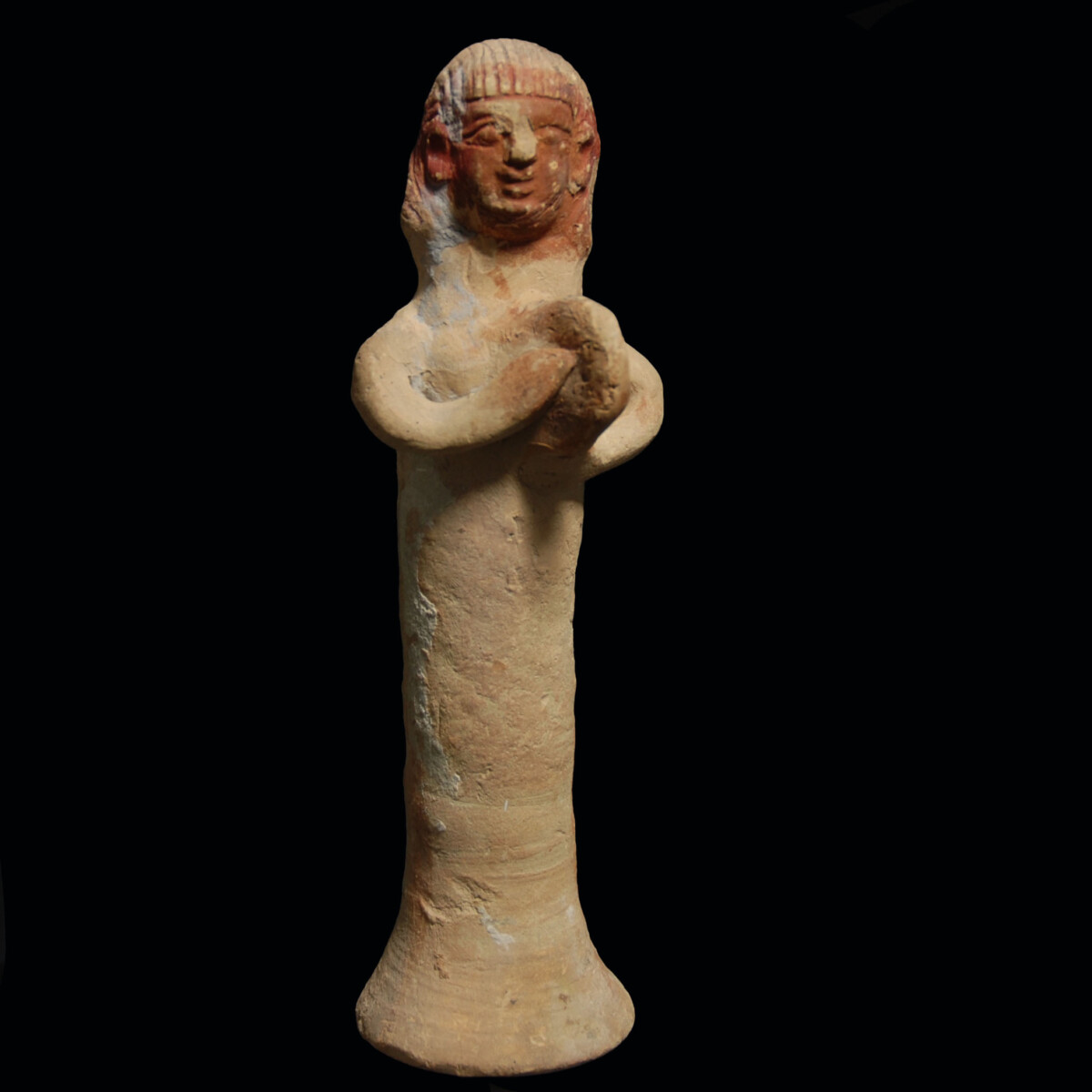
|
|
|
|
|
Completely preserved, large terracotta statuette of a tambourine player from the Cypriot archaic period. The stylized body is cylindrically formed on a potter’s wheel and hollow inside. The arms are formed by hand and hold the tambourine in front of the chest. The face is moulded and painted in red. The mouth is formed to a smile and the eyes are almond-shaped with long eyeliners. The hair is covered with parallel strands on the head and cascade behind the large ears. The back of the head is flat. The statuette belongs to the so-called Kamelarga style, which is named after the excavation site in Cyprus. See for the type a head of a very similar, if not from the same form in the Metropolitan Museum of Art with the Accession Number 74.51.1522.
|
Provenance: German private collection J. Gubrod (died in 2017), acquired between 1960 to 1990 on the German art market. Thence by descent to Micaela Gutbrod, Munich, Germany.
Dimensions: 21 cm high
Price: 1 600 Euro
|
|
Komplett erhaltene, große Terrakotta-Statuette einer Tamburin-Spielerin aus zypriotisch archaischer Zeit. Der stilisierte Körper ist auf dem Töpferrad zylindrisch geformt und innen hohl. Die Arme sind handgeformt und halten das Tamburin vor der Brust. Das Gesicht wiederum ist aus der Form gepresst und rot bemalt. Der Mund ist zu einem Lächeln geformt und die Augen sind mandelförmig mit langen Lidstrichen. Die Haare bedecken in parallelen Strähnen den Kopf und fallen seitlich hinter die großen Ohren. Der Hinterkopf ist flach. Die Statuette zählt zum sogenannten Kamelarga-Stil, der nach dem Fundort auf Zypern benannt ist. Vergleiche zum Typus einen Kopf aus einer sehr ähnlichen, wenn nicht der gleichen Form im Metropolitan Museum of Art mit der Accession Number 74.51.1522.
|
Provenienz: Deutsche Privatsammlung J. Gutbrod (verstorben 2017), erworben in den 1960er bis 1990er Jahren am deutschen Kunstmarkt. Danach durch Erbe an Micaela Gutbrod, München.
Höhe: 21 cm
Preis: 1.600 Euro
|
|
|
|
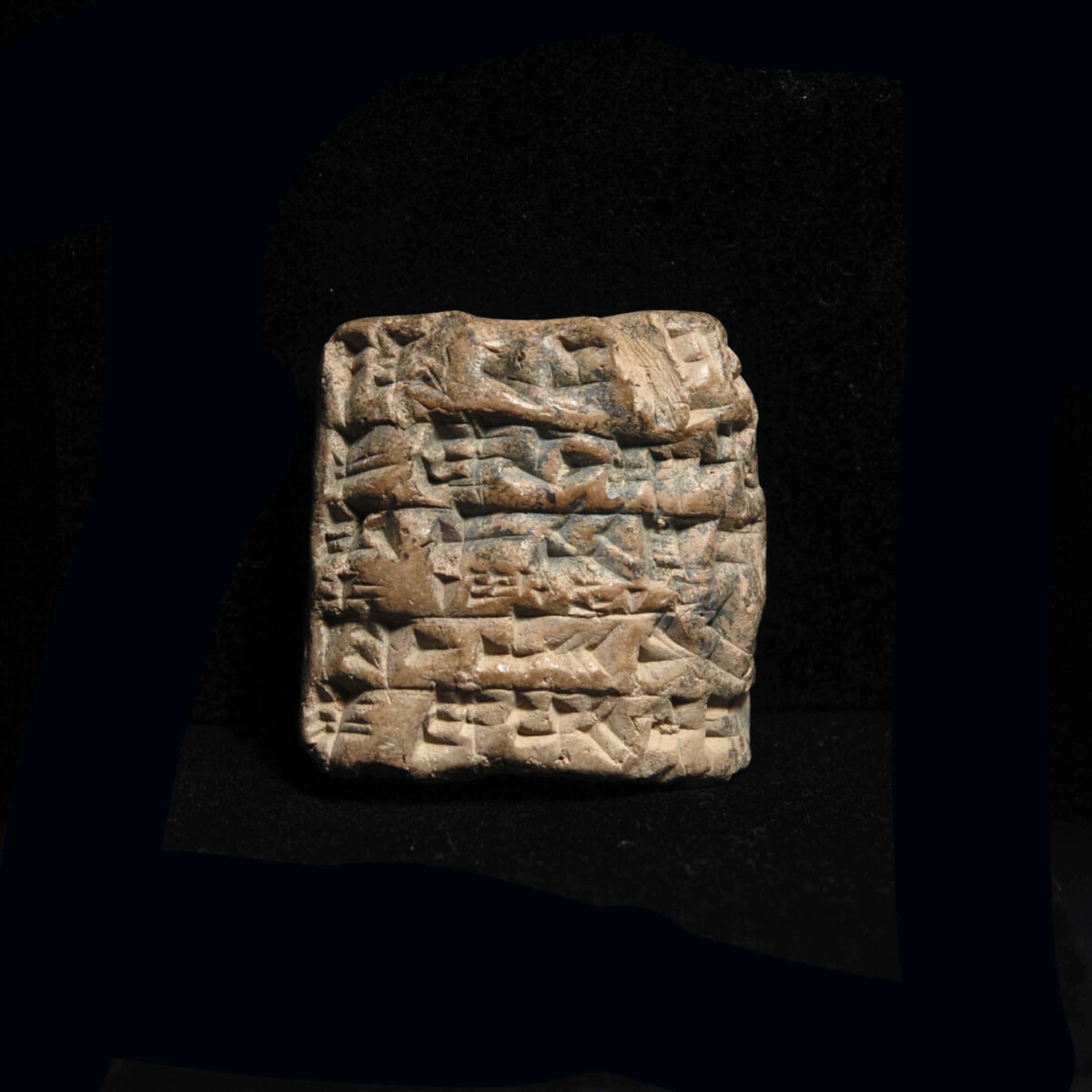
|
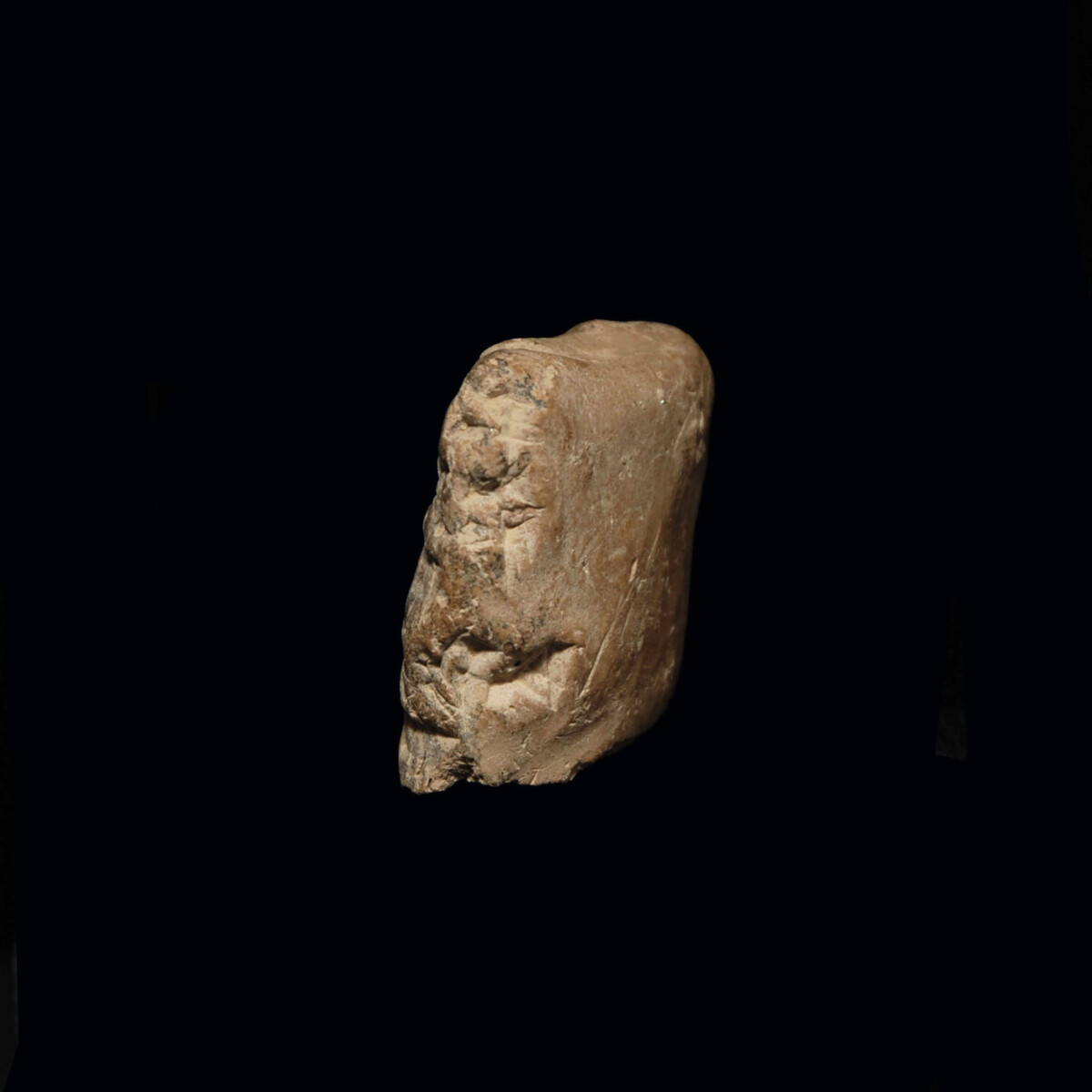
|
|
|
|
Mesopotamia – around 1800 B.C.
|
Cuneiform tablet with a five-line inscription mentioning Geštu-Sin, God of the moon. Interesting is the third line which shows two different typefaces, one drawn with a larger, the other one with a smaller stylus. It possibly is a transference for a religious dedication, namely by “Pl-Sîn, brother of…”. In line two the words “Sipa”, which means “shepherd”, as well as “Kur” for “land” is readable. This indicates that the tablet originally had an agricultural content, hence served as a contract or an agreement before it was supplemented with a dedication for the God of the moon.
|
Provenance: From an old English collection, late 1980s.
Dimensions: 4.5 cm x 4.5 cm
Price: 2 200 Euro
|
|
|
Mesopotamien – um 1800 v. Chr.
|
Keilschrift-Tafel mit fünfzeiliger Inschrift, die Geštu-Sin, den Mondgott erwähnt. Auffällig ist Zeile 3, die zwei verschiedene Schriftbilder aufweist, das eine mit einem größeren, das andere mit einem kleinen Griffel gezogen. Es handelt sich wohl um eine Überschreibung für eine religiöse Widmung, namentlich durch „Pl-Sîn, Bruder des ...“. In Zeile zwei sind die Worte „Sipa“, was „Hirte“ bedeutet sowie „Kur“ für „Land“ lesbar. Das deutet darauf hin, dass die Tafel ursprünglich einen landwirtschaftlichen Inhalt hatte, also als Vertrag oder Vereinbarung diente, ehe sie um eine Widmung für den Mondgott ergänzt wurde.
|
Provenienz: Aus alter englischer Sammlung Ende der 1980er Jahre.
Dimensionen: 4,5 cm x 4,5 cm
Preis: 2.200 Euro
|
|
|
|
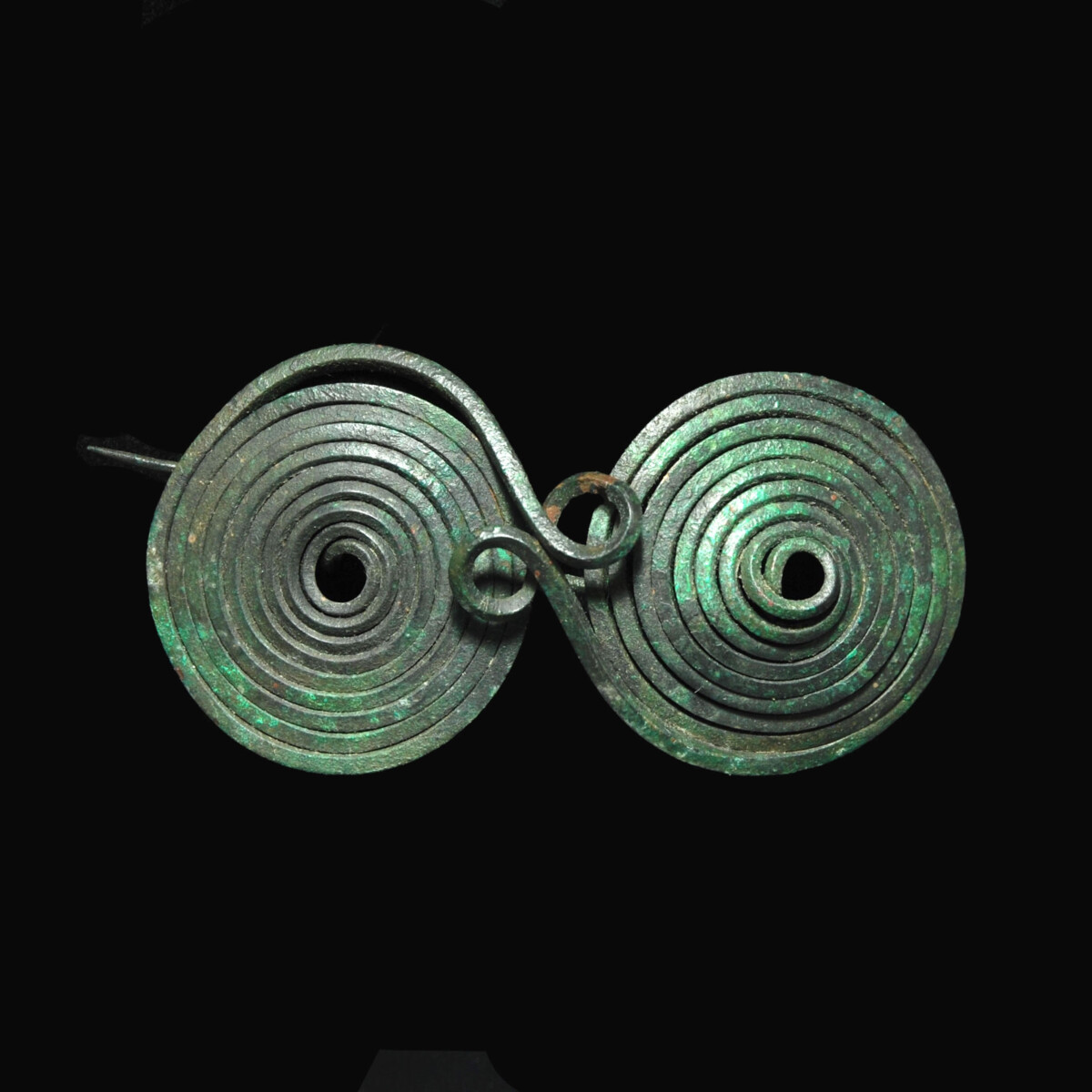
|
|
|
|
Middle Europe – 9th-8th century B.C.
|
Fibula of a square wire with two opposing coiled spiral discs. Between the spirals sits a double loop. From one of the spiral centres the wire continues as the pin. The catch-plate at the other spiral is formed by a hook-shaped bent wire-end. Brooches like the present one were widespread during the Late Bronze Period to the Early Iron Age in Southeast Germany, Austria, Czech Republic, Slovakia, Poland, Italy down to Greece.
|
Provenance: From a New York private collection, 1990s.
Dimensions: 13.5 cm long
Price: 900 Euro
|
|
|
Mitteleuropa – 9.-8. Jahrhundert v. Chr.
|
Fibel aus vierkantigem Draht mit zwei gegenständig aufgerollten Spiralscheiben. Zwischen den Spiralen sitzt eine Achterschleife. Aus dem einen Spiralauge setzt sich der Draht als Nadel fort. Ein hakenförmig gebogenes Drahtende am anderen Spiralauge bildet den Nadelhalter. Fibeln wie diese waren in der jüngeren Bronzezeit bis zur älteren Eisenzeit in Südostdeutschland, Österreich, Tschechien, der Slowakei, Polen, Italien bis hin nach Griechenland verbreitet.
|
Provenienz: Aus New Yorker Privatsammlung, 1990er Jahre.
Länge: 13,5 cm
Preis: 900 Euro
|
|
|
|
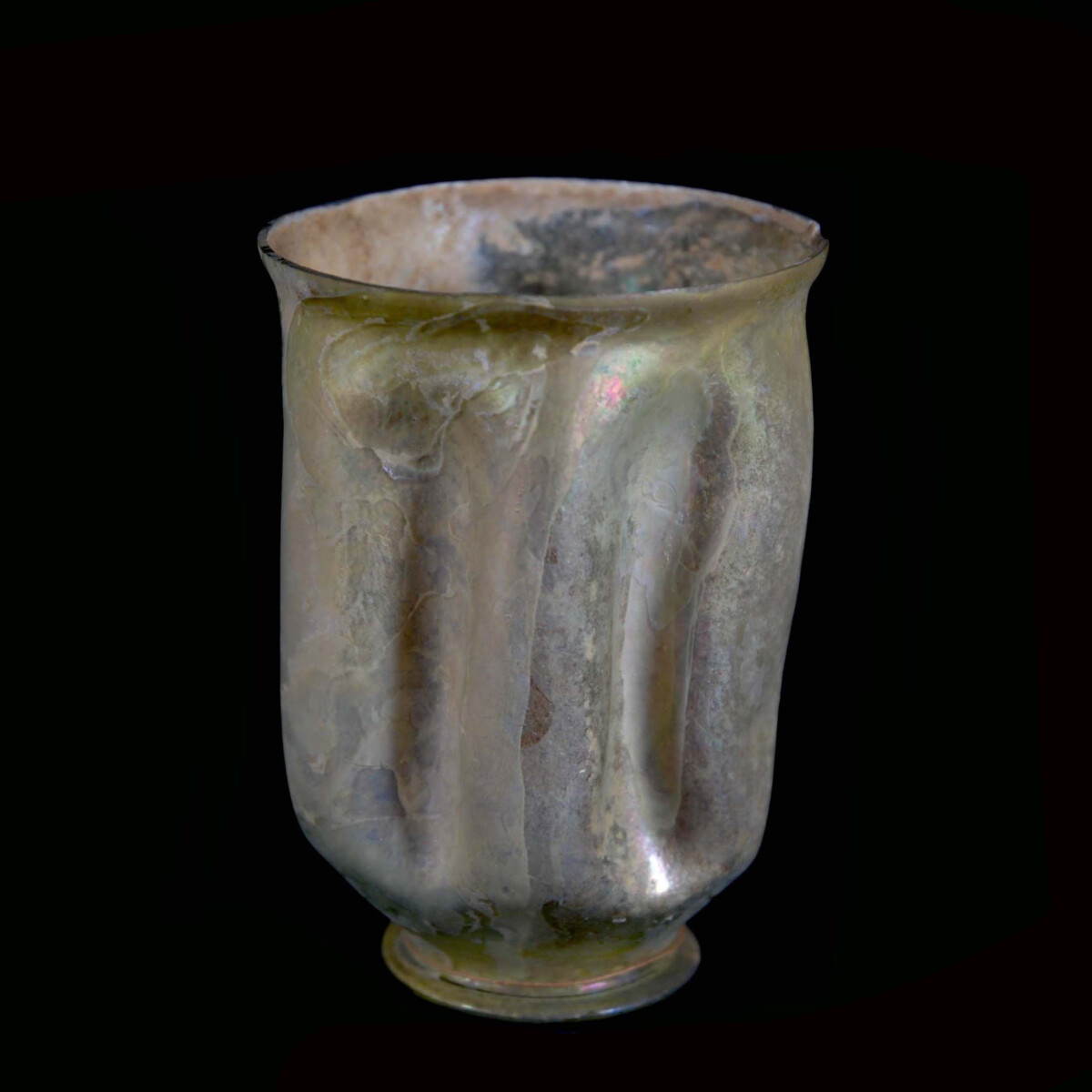
|
|
Roman Empire – 3rd century A.D.
|
Thin walled, indented and high beaker of yellowish-green clear glass. The rim is slightly pulled outwards. The vessel stands on a foot ring pulled out from the wall. The corpus with six deep, vertical indentations. With beautiful, silver shinning iridescence. With an old collection label with the number 147.
|
Provenance: From the private collection of the French archaeologist Louis-Gabriel Bellon (1819-1899). Since over 120 years in a family estate.
Dimensions: 9.6 cm high
Price: 680 Euro
|
|
|
Römisches Reich – 3. Jahrhundert n. Chr.
|
Dünnwandiger hoher Faltenbecher aus gelblich-grünem Klarglas. Der Rand leicht nach außen gezogen. Das Gefäß steht auf einem aus der Wandung gezogenem Standring. Der Korpus mit sechs tiefen, vertikalen Dellen. Mit schöner, Silber schimmernder Irisierung. Mit altem Sammlungsetikett mit der Nummer 147.
|
Provenienz: Aus der Privatsammlung des französischen Archäologen Louis-Gabriel Bellon (1819-1899). Seit über 120 Jahren in Familienbesitz.
Höhe: 9,6 cm
Preis: 680 Euro
|
|
|
|
|
|
|
|
|
CHRISTOPH BACHER ARCHÄOLOGIE ANCIENT ART GmbH
|
Galerie: Stubenring 20, A-1010 Wien
Showroom: Untere Viaduktgasse 55, A-1030 Wien
|
|
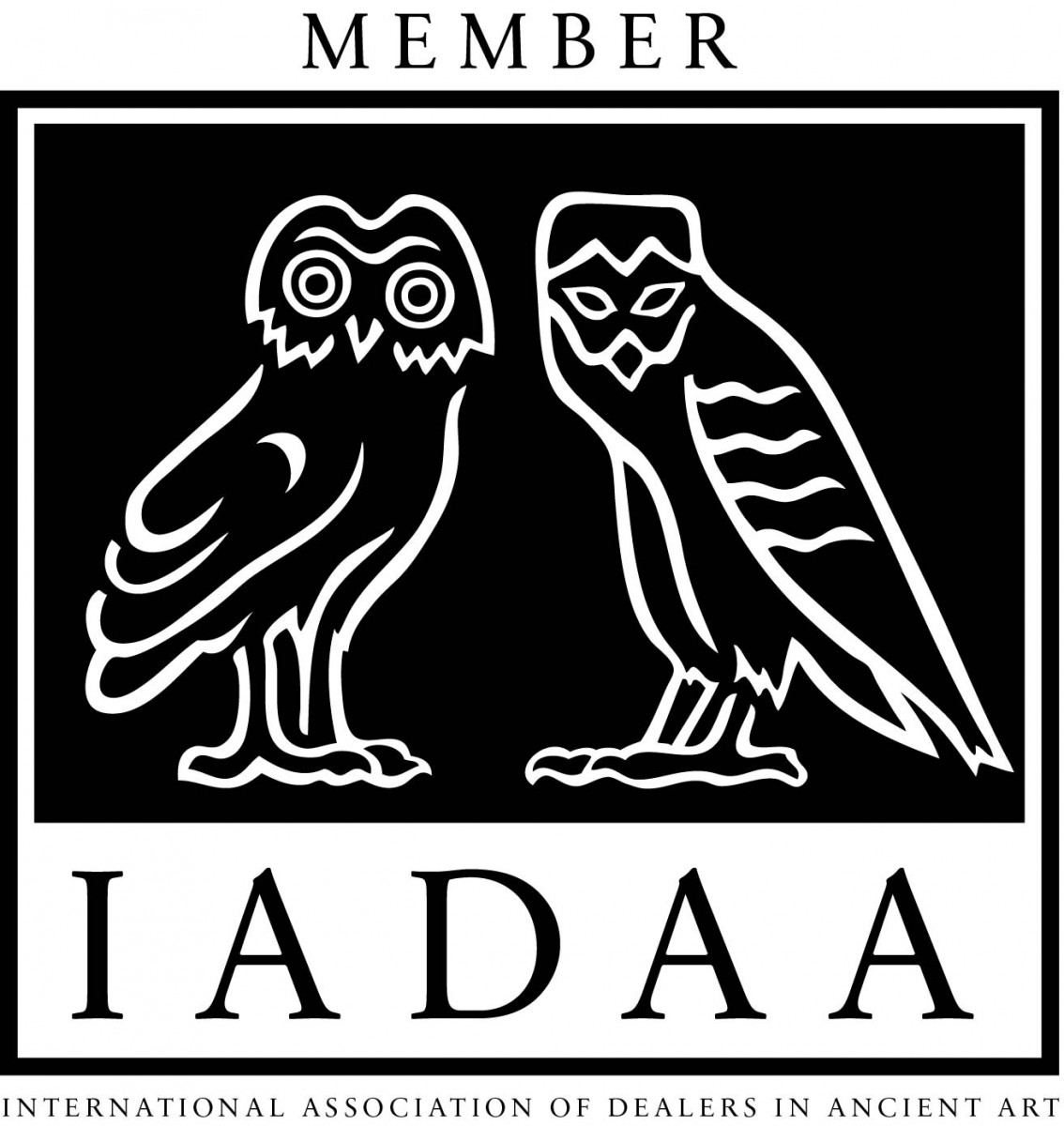
|
|
|
|